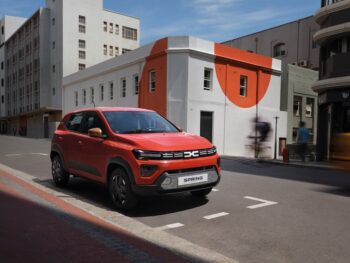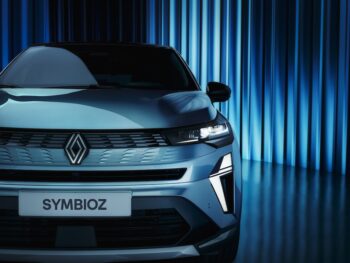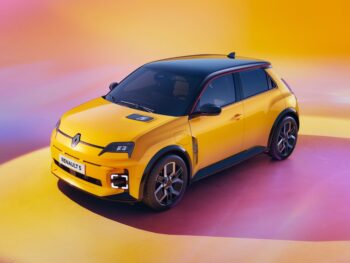Interview: Renault Group’s Justin Costello on fleet plans and EVs
Having assumed the role of head of fleet at Renault Group in March, Justin Costello has big plans for the brands he represents – helped by some exciting products heading down the track. By John Challen.
You’re relatively new into the role, how have you found the first few months?
JC: I’d been in a fleet role at another OEM for 10 years and what particularly impressed me when I arrived here was the breadth of models within the Renault Group. I’m looking after Renault cars, Renault vans and the Dacia and Alpine brands, so there’s a lot of product on the horizon.

Justin Costello, head of fleet at Renault Group
Within fleet, we’ve got some great customers, but what struck me was the big opportunity we have with passenger cars. Our market share there is quite low, but with all the new models coming in – particularly around BEV and hybrid – there is the potential to improve our position. I’ve been astounded by the technology and the driving dynamics within the range now, so it’s up to us to take advantage and raise the awareness and get drivers into the product.
Is the sheer breadth of models a challenge or an opportunity for the group? JC: For me, it’s a massive positive because I’m able to offer an end-to-end solution: with Dacia, we’ve got great affordability; Renault has a brilliant range of models – and high-quality specifications and aesthetics, alongside impressive interior and exterior design and technology; our vans have gone from strength to strength – especially in the BEV segment – and when we get to fleet options with Alpine in 2025, those cars will be very clearly defined with their own target market, specification and pricing.
What are the different fleet challenges with both Renault and Dacia?
JC: Awareness. Renault has come a long way in the past six years, but we’ve kept some great, iconic heritage model names, which is so important. Megane is really well known, Scenic is almost universal and Renault 5 is iconic. Our job is to demonstrate what those models bring, compared to their predecessors. The other challenge is new trends – and the vehicles that drivers might not be aware of. Symbioz and Rafale, for example, are new names for us and customers need to understand where they fit within their segments and what their benefits are – which, again, comes back to awareness. The biggest challenge within that education is making sure people drive the vehicle. Whether it’s through our demo programme, via retailers or at events, we need to get as many drivers and fleet decision-makers as possible behind the wheel.
How do you envisage growth for Renault and Dacia in the fleet sector?
JC: The Renault vans side is very strong in fleets, with around 50%, but passenger car is more like 30%. So we are definitely looking to grow that – and the same with Dacia, which is currently 20% fleet. Dacia has historically been retail-focused, but it is very much interested in growing in the fleet space and there’s plenty of opportunity for that to happen. The Spring EV for example – starting from £14,995 – is perfect for salary sacrifice. The model range will naturally drive Dacia as a whole, but the interest in the fleet market and how it can grow in that space will also make a difference.

The Dacia Spring EV at £14,995 looks a strong contender for salary sacrifice
What I’ve found at recent events, when we’ve had both brands side-by-side, is that drivers have been really surprised about the quality, technology and specification of Dacia. I’m excited about Spring, but also the C-segment model coming next year and new Duster. In fact, there’s a whole array of Dacia models that will land well in the fleet market.
One of the things that helps us, compared with other new entrants, is that we’ve already got a nationwide aftersales solution. So it’s not like other brands that are coming into the market and starting from scratch – we’ve got that combined aftersales operation from day one. That’s something else that we need to make drivers and fleets more aware of.
How do you convince drivers that Renault and Dacia products are right for them?
JC: The awards that we’ve been winning across the industry recently really help, as does the high specification we have within our vehicles. If you look at the Dacia Spring, for example, there’s a 137-mile range – meanwhile the Scenic offers Solarbay – an innovative roof that can be lightened and darkened. A combination of awards, specification and aesthetic appeal have helped both brands land really well with fleets and drivers like the fact that they are a bit different to traditional offerings.
What do you see as the most popular models for fleets?

Renault Symbioz is a new name
JC: Right now, Clio has become the benchmark small car. So, again, multiple awards, well received by customers and a great car in a popular segment. There is also a huge amount of excitement around Scenic and – because SUVs are popular segment with fleets – it is naturally doing very well.
Moving into next year, Rafale PHEV is interesting – we’ve not had a plugin hybrid for a while, so it’s an important car for the brand.
And then there’s the Renault 5 – what do you expect that car’s fleet impact to be?
JC: I think Renault 5 will do a number of things for us and the industry. For us, it will help us with the whole awareness angle, because there’s so much anticipation for the car and it’s a huge marketing campaign for us around the products and the brand. I think it’s going to attract a broad range of drivers. I think it will be a great salary sacrifice car, but I also think it will do well as a company car.

Renault 5 promises to be really well specced
I don’t think everyone is interested in the ‘traditional’ company car any more. Segments have been eroded, the need for a certain size of vehicle has diminished, with drivers being much more flexible and tailored in their approach to what they need.
Because the Renault 5 is going to be really well-specced, with a funky look and great selection of materials, I think we will see a lot of people downsizing.
It will prove popular in public sector fleets, too. But then there’s also Renault 4 just around the corner and other models on the way – it’s the mid-point of a really exciting journey.
Coming back to Alpine, what can fleet drivers expect to see from the sub-brand?
JC: Realistically, 2025 is going to the year for movement there. Right now, there’s obviously the A110, which is a great sports car, but not a core consideration for fleets.

A290 will be the first electric vehicle to come from the Alpine sub-brand
But the A290 will be the first electric vehicle to come – a small, sporty vehicle that heralds back to Alpine’s heritage; it will be a big differentiator to Renault.
There will be another Alpine EV coming towards the end of 2025 and then more following after that. That combination of heritage, premium materials, sportiness and engaging driving dynamics is something that will get a lot of people excited.
The secret to win drivers over to BEVs is to build really good cars that happen to be electric. That’s what Renault has done with Scenic – and now Alpine is going in the same direction. If you build cars that are fun, engaging and sporty, drivers will want them.
What potential is there for innovations such as the PowerBox from Mobilize within fleets?
JC: Renault 5 will introduce bi-directional charging and it’s also on the Dacia Spring, too. I think it could be a game-changer and will create a conversation about broadening the definition of TCO. If we think about what PowerBox allows people to do, the car could be charging at super off-peak and sending energy back into the house at peak times. So there is the potential to massively reduce energy bills and increase efficiency. When you then start to think about solar panels, they can charge the car and the home and it creates an entire ecosystem.
Finally, on a personal level, what would you like to achieve in your role in the next 18 months?
JC: If I had one objective, it would be growing the awareness of the Renault Group proposition – and, within that, cementing our place in the fleet market in the long term. If I could have customers, in three, six, nine, 12 or 18 months – whatever the period might be – heralding Renault as a core fleet manufacturer that is working well, listening and building really good long-term relationships and partnerships, that would be success in my eyes.















